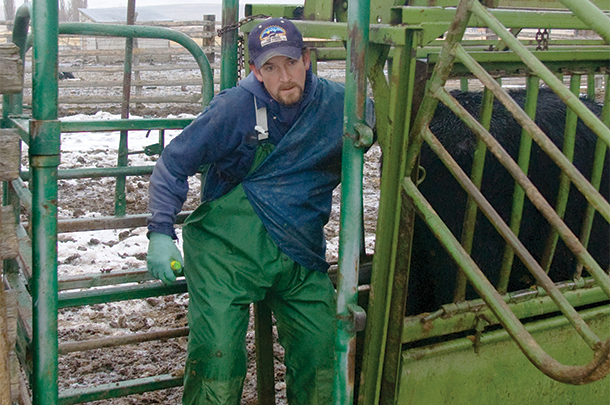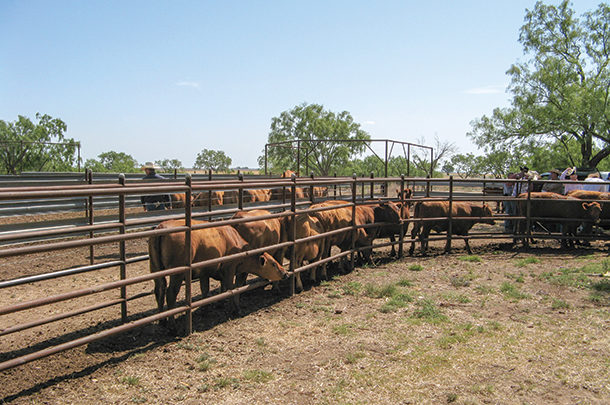Any large animal practitioner who has been in business for a few years will say that they have trouble sleeping at night due to aching shoulders, knees and other body parts. Neglected working pens are not only hard on your vet, but they are also a safety hazard to you, your family, employees and cattle.
“I was in private practice for a number of years before joining the Texas A&M system, and during that time, I often had to place myself in precarious situations in order to treat cattle. Once I was required to stand on a bucket in order to gain access to the animal,” said Tom Hairgrove, DVM, Texas A&M AgriLife Extension. “On another occasion, a huge rattlesnake came slithering across the pen where I was working. He had come from beneath a small, adjoining building used for storing frozen semen. A snake that size can make it hard to concentrate on your work in addition to posing a safety risk.”
Rob Conley, DVM, Conley Vet Services of Vernon, Texas, related an experience where a large cow bolted from a squeeze chute wearing a 6-foot headgate around her neck. “That was quite a rodeo with myself and four cowboys trying to dodge a mad cow with a 6-foot head extension in a 20-by-20-foot pen.”
Fortunately, these incidents did not result in serious injuries, but the risks could have been avoided with good pen design, maintenance and an understanding of the moving parts.
Design for safety
“Safety is paramount for my students, ranch hands and cattle,” said Glennon Mays, DVM, clinical associate professor with the College of Veterinary Medicine at Texas A&M University. “I instruct my students to study all the moving parts in a cattle handling facility including gates, squeeze chutes, palpation boxes and calf tables. After they understand how the parts work, I tell them to plan their movements and functions to avoid injury.”
“In some chutes, the hinges hang downward when an animal is squeezed,” continued Mays. “These hinges can limit the vet’s work space if he is helping deliver a calf, palpating or working at the rear of an animal for any reason. He can also sustain injuries if he is standing in the hinges’ path when the squeeze is applied. A tailgate raised and lowered with a rope can present a hazard when a vet works inside the chute at the rear of an animal. If it does not securely lock, an impatient animal can raise the gate, enter the chute and pin the veterinarian against the cow being attended.”
Producers should assume the role of a vet and mimic his or her procedures, with or without a cow, to learn locations of snags and danger points. Once they are identified, attempt to remove the hazards.
“Elaborate cattle handling facilities are not a prerequisite for maintaining a safe and efficient working environment,” said Conley. “A pen design that allows an easy flow of cattle and a functional squeeze chute are the primary requirements. Depending upon management practices, a palpation box may also be needed. A crowd chute made of pipe with only a headgate does not provide safety or efficient cattle handling.”
“The squeeze chute doesn’t have to contain all the latest features, but it does need to provide easy and safe access to the target area of the animal. The vet should not have to reach over or under a bar in the chute or stand on a bucket to reach the animal,” said Hairgrove. “Side gates are important for access to a cow, especially if she has laid down in the chute. Otherwise, it is very hard to get her up.”
“A pen design that worked well in the past may not be suitable for today’s cattle and management practices,” continued Conley. “I work in several locations where the crowd chutes were made for horned cattle. The present general practice is to raise polled cattle or dehorn calves, and without horns, cattle can turn around in wide chutes made for horned cattle.”
Maintenance is important
“Cleanliness is an important part of maintenance and safety,” said Hairgrove. “Avoid providing a habitat for snakes, rats, mice, skunks and scorpions by keeping pens free of weeds and debris. Generally, cattle are only worked twice a year, allowing pens and chutes to deteriorate during the idle periods.”
“Repairing facilities while working cattle is not a good combination for efficiency and safety. Before penning cattle, we walk through the entire working facility to determine if they are clean and in good working order. We test all pen and chute gates to ensure they swing easily and latch securely. Broken boards and welded joints are repaired and yellow jacket and wasp nests are removed,” said Rusty Alexander, Alexander Livestock, Lampasas, Texas.
Squeeze chutes need special attention prior to penning cattle because they are the center of activity. Basically, there are two types of chutes – friction and hydraulic. Lightly oil all the movable parts on friction equipment. Never use grease, because it tends to harden in summer, making gates and squeezes unworkable. Hydraulic chutes should not receive any type of lubricant.
“When building pens, provide a way to remove the squeeze chute,” said Conley. “Squeeze chutes eventually wear out and need replaced. I have witnessed pen designs that completely ‘landlock’ the squeeze chute, leaving no avenue for removal or bringing in a replacement.”

“Many veterinarians now refuse to palpate cattle without the protection of a palpation cage,” said Alexander. “Producers who want cows palpated should either consider investing in a palpation cage or have space behind the squeeze chute for a portable one. If the squeeze chute has a hydraulic end gate, it should be placed behind the palpation cage with a block gate in front. It is too easy to accidently hit the hydraulic controls, allowing animal movement while the vet’s arm is inserted in a cow’s rectum. A friction block gate protects the person standing at the rear of the animal.”
“Some palpation boxes have flooring and some do not,” said Alexander. “For those without flooring, maintain level ground inside the cage. Do not allow mounding or wallowing that puts the vet or technician in an awkward standing position. Flooring in palpation boxes should be kept in good condition as well. Some veterinarians and artificial insemination technicians have portable palpation boxes which they can use if one is not available on the ranch.”
Large animal veterinarians are in short supply. Let’s make their job more attractive by providing them a safe working environment. ![]()
PHOTO 1: Keep working pens free of debris and tall vegetation. Photo by Robert Fears.
PHOTO 2: A palpation cage or an adequate amount of space behind the chute gives the vet more adequate protection when examining cows. Photo by Fredric Ridenour.
Robert Fears is a freelance writer based in Georgetown, Texas.









